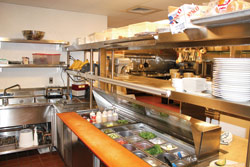As the tastes and needs of their clientele continue to evolve, so too must the way senior care facilities manage their foodservice operations. Such is the case with Atria on the Hudson, an Ossining, N.Y.-based senior care facility with more than 60 residents.

Prior to the renovation, the community provided one dining area for all of its residents. Now, the culinary offerings include three dining venues that resemble a top-flight hotel more than a typical senior living community.
The renovation’s goal was to create a culinary-oriented back of house, while focusing on hospitality in the front of house. “I don’t think anyone else is doing what we’re doing here,” says Chad Welch, director of culinary development for Atria on the Hudson’s parent company, Atria Senior Living. “We’ve changed our department from food services to culinary services. It’s a company-wide rebranding and changing mindset.”
In addition to Palisades, the main restaurant, Atria on the Hudson offers lighter fare at its cocktail lounge and indoor pool, along with separate menus for room service and an area for dementia patients. A 24-hour grab-and-go café provides sandwiches, salads, vegetable sides and beverages.
The biggest change with the foodservice renovation was replacing banquet-style cooking and cyclical menus with restaurant-style production and service. Food is available at all hours, rather than at designated meal times.
More subtle changes have also helped transform the operation. Instead of utilizing portion-control items, like packaged condiments, staff now serve jellies, ketchup and other toppings in ramekins. Staff also make stocks for soups and sauces in-house, rather than using bases. In addition, staff present trays for sick residents in room service fashion with stainless covers, china and glassware.
A total departure from its predecessor, the Palisades dining room features a menu of made-to-order food items instead of traditional, institutional dining options. As a result, staff no longer need to stand in the dining room with attendance sheets to keep track of diners. Atria is implementing sophisticated point-of-sale systems to track all meals and monitor resident diets and meal checks.
Palisades’ seven-page menu includes traditional breakfast items, such as eggs and bacon, alongside heartier fare such as breakfast wraps and corned beef hash. Among the five salad selections is a roasted beet salad with sliced fennel, orange segments and shaved blue cheese. Residents can choose from four soups daily. The menu also features nine signature items, along with cyclical daily specials. Entrees include pan-seared tilapia with citrus ginger sauce, New York strip steak, oven-roasted herb-crusted rack of lamb, French meat loaf, roasted vegetable lasagna and roasted chicken quarters. One of the most popular items is the croque madame, a traditional bistro sandwich: grilled ham and cheese, with egg and Mornay sauce on top.
“In the past, the focus was on embellishing the cycle menu to make it more appealing,” Welch says. “Now we can look at the entire menu and inform diners about our daily specials. It’s a more realistic approach.”
Like the menu, the 2,500-square-foot kitchen was rebuilt from the ground up to accommodate cook-to-order service and serve multiple dining areas.
Prior to the renovation, Atria on the Hudson’s kitchen resembled traditional assisted living kitchens, with a hot line under a hood containing a grill and cooking equipment alongside a service line with a steam table. The adjacent cold line consisted of an undercounter refrigerator and countertop with ice bin.
The new setup still uses a line format, but the cold side is now separate. “One of the most significant additions is the refrigerated prep-holding area,” Welch says. “Another great addition is the pantry, which is a separate area for cold items, such as salads, sandwiches and desserts. These items previously would come off the hot line in a designated space that included a reach-in. Now there is a dedicated section for this production.”
With the new equipment package, the focus was on functionality and durability. The new cookline includes a fryer, range, griddle, broiler, salamander, tilt braiser, dual convection oven and steam table. Plate warmers, warming drawers and refrigerated drawers were also added. Drop-in soup warmers on the front line are accessible to servers. A built-out ice cream freezer in the center of the kitchen functions as a sundae station and includes a dipping well and condiment area. The only equipment remaining from the former kitchen is a walk-in refrigerator and freezer.
There was a minor tweak to the kitchen after the renovation was completed. “The biggest thing we may have initially missed on paper was prep space,” Welch says. “We had to add prep tables and a couple shelves for dish-station drying racks after the project was finished. So much thought goes into the planning, but once the kitchen is up and running, there are sometimes little changes that need to be made.”
The transformation extends to the dining room, which is modern and casual, yet elegant with neutral earth tones. Up to 75 residents can be seated at tables and banquettes that offer a view of a courtyard and fountain. Even the tableware received an overhaul, with 10 ½-inch restaurant-style dinnerware replacing the nine-inch assisted living plates.
Food is purchased separately by each Atria community. Although this expense initially rose due to the additional dining areas, Welch expects the à la carte format will be more affordable in the long run. “We’re getting away from premade product, so there is less waste,” he says. “With the old menu, we had to guesstimate how many portions to make and then couldn’t utilize the leftovers. Now we have both higher quality and cross utilization. By doing things the right way, we save money.”
Atria’s multigenerational approach for senior residents that are in different decades of life could be the wave of the future.
By transforming its traditional senior care foodservice facilities into a higher-quality culinary experience, Atria on the Hudson has helped propel this segment into the twenty-first century.




